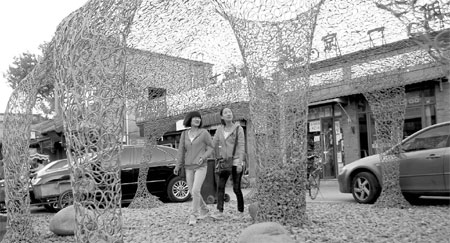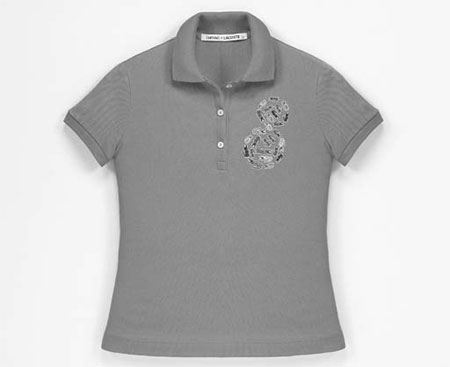A hybrid in the hutong
Updated: 2012-10-28 16:30
By Chen Jie (China Daily)
|
|||||||||||
|
The Campana brothers' installation, the wire-like "tree", creates a natural inner space and shade in the Dashilar district. Zou Hong / China Daily |
|
Campana brothers, Fernando and Humberto. Photos Provided to China Daily |
|
In the Campana brothers' design of the new Lacoste Polo, the iconic crocodile emblem is arranged into a spiral. |
A 'tree' made of wire in a traditional Beijing street adds a natural element to the ancient cityscape, Chen Jie reports.
To those who know Beijing well, Dashilar means authentic and old: Teahouses, Peking Opera theaters and time-honored stores, small and shabby restaurants in hutong selling baodu, chaogan and luzhu snacks.
Which brings us to a newly erected, strange, green, canopy-like structure situated at the end of Dashilar Xijie Street.

Brazilian designers the Campana brothers, Humberto and Fernando, say it is "a dialogue between nature and the city" and also a gift to China from Brazil, hence its hybrid name, "Brachina".
Inspired by cashew nut trees in their hometown, the siblings created it out of green iron wire with a diameter of 0.5 centimeters.
It took several Chinese workers 10 days to weave and weld the "tree" into place on a floor of stones and rubble. The wire-like twigs "grow" crazily so as to create a natural inner space and shade. It feels like walking in a wood, in the city.
Commissioned by Beijing Design Week, held in October, the brothers visited Dashilar in January and decided to add a natural element to the community.
"Dashilar is a small community in a metropolitan area and most of the buildings are old and gray. Green is visually striking and the tree makes you feel vibrant," says the elder brother Humberto.
"I stand at the street corner to watch people walking through it and take photos of it. I know they love it," he adds.
"We hope to stay in Beijing longer to visit some traditional craftsmen. We know China has a long tradition of craftsmanship, refined techniques and folk design."
The Brachina is not the only gift the brothers have presented in Beijing this autumn. Their design of Lacoste's annual Holiday Collector's series will be in stores from November. The new Lacoste Polo features the iconic crocodile emblem arranged into a spiral.
It is the second time the French company has commissioned the duo. Their 2009 Holiday Collector's series, designed by the brothers, was a Lacoste fan favorite, says Frank Cancelloni, CEO of the Asia-Pacific region.
Humberto says there are many crocodiles in the Jacare River running through his hometown in Brazil, which was their inspiration for many years.
Back in 2003, while exploring new forms of upholstering, the designer brothers created a technique of rolling together different sorts of materials.
From fabrics, carpets, felt and rubber nets, flat and three-dimensional elements were formed into colorful swirls and applied to an array of limited edition pieces.
They created chairs, tables and puff seats out of this rolling shape, which has since become a Campana trademark. On this occasion they rolled Lacoste's trademark crocodiles into the shape.
The 59-year-old Humberto says it took some 40 years to discover himself as an artist.
His primary-school-teacher mother hoped her elder son would become a doctor or a lawyer, which is why he attended law school for five years.
Even so, he enjoyed making things out of clay and making sculptures for fun. His younger brother Fernando, 41, learned architecture at the Sao Paulo School of Fine Arts.
The two teamed up to create furniture in the early 1980s and have branched out into other areas of design since then. They won international recognition in 1998 when they became the first Brazilian artists to exhibit their work Project 66 at the Museum of Modern Art in New York.
"It was a breakthrough. We were only famous in Brazil before that. MoMA's exhibition helped us to be commercially successful," Humberto says.
He also goes on to compare his relationship with his brother to David Lynch's 1999 movie The Straight Story.
"As two individual designers, we have different ideas all the time, like your Chinese yin and yang. But I am the older brother and I know the tricky, I say yes, he says no. So if I want 'no', I say 'yes'."
Contact the writer at chenjie@chinadaily.com.cn.
Today's Top News
Rescuers race against time for quake victims
Telecom workers restore links
Coal mine blast kills 18 in Jilin
Intl scholarship puts China on the map
More bird flu patients discharged
Gold loses sheen, but still a safe bet
US 'turns blind eye to human rights'
Telecom workers restore links
Hot Topics
Lunar probe , China growth forecasts, Emission rules get tougher, China seen through 'colored lens', International board,
Editor's Picks

|

|

|

|

|

|








